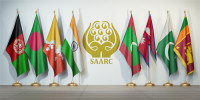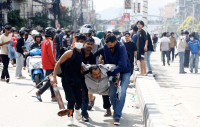Opinion
Tracking the transition
Track II diplomacy supports a collaborative process of peacebuilding and expedites developmentYogendra P Paneru
Democracy and peace cannot be sustained without a reliable civil society. Therefore, civil society activism is one of the most important factors in determining whether post-conflict peace/state building will be successful. In April 2006, the presence of a vibrant civil society activism was instrumental in creating a conducive environment for the 21-day long people’s movement and for reaching a Comprehensive Peace Agreement between the former rebels and the political parties. Nevertheless, the same civil society received enormous criticism for being indoctrinated and losing its essence in the transition.
Second track
After the Cold War, many nations that experienced violent conflicts have been reduced by almost half. Unofficial intermediation, often known as citizen or civil society diplomacy (Track II diplomacy), was developed in response to the profound challenge that these complex conflicts pose to build enduring peace. This kind of diplomacy is instrumental as it brings together professionals, opinion makers and individuals. The uniqueness of Track II diplomacy is its ability to work in the absence of official representatives and without seeking official invitations from the parties involved. It provides latitudes, which are not available in formal settings, supports a collaborative process of peacebuilding and contributes to expedite development initiatives. Throughout the negotiation process, Track II diplomats have responsibilities and obligations to society and their job is to check, aid and activate conflict resolution. When a divide exists between the political parties, Track II representatives intensify their activities. Likewise, foreign diplomats also multiply their mobility to fill the gap, which is common in international relations and peacebuilding.
Reputed Nepali Track II diplomats including Daman Nath Dhungana, Padma Ratna Tuladhar and a few others who have helped parties in conflict come together, narrowed down divisive issues and facilitated dialogue during the conflict era. However, this kind of diplomacy did not work while settling disputes in the last Constituent Assembly (CA). A few key Track II diplomats, including Dhungana, have argued that neither past governments (2006-2012) nor the CA asked them or any other civil society individuals to lead negotiation processes. Civil society itself did not attempt to develop mutual proposals either, saying this was the job of political parties.
Working informally
Of course, it might be seen as excessive if civil society members were welcomed and requested to assist the parties in setting up common agendas by acting as a ‘go-between’, organising problem-solving workshops, managing dialogues and ensuring participation of all segments of society. Yet, Track II is not a kind of diplomacy that requires a formal invitation for assistance. Even in the absence of a formal request, Dhungana, Tuladhar and a few others who are recognised as citizen diplomats, demonstrated new proposals and lobbied to stakeholders over the most disputed issues that simultaneously forced the parties to reach a deal.
Expert Track II diplomats choose to foster unofficial conversations rather than expecting formal invitations. Past examples have shown that Track II is not well prepared in Nepal to utilise the advantages available. For instance, when the Maoists rejected holding the elections on a previously declared date, former US President Jimmy Carter, also recognised as a Track II diplomat internationally, flooded the electoral proposal of 30 and 70 percent for first-past-the-post and proportional electoral systems respectively. Carter lobbied for the proposal in multiple forums, which later pressured the parties to move forward. However, similar impartial diplomacy and consistent lobby did not happen at the local level.
Citizen diplomacy requires tireless movement and intense interactions between all kinds of stakeholders, and utilises shuttle diplomacy to reach out. It is essential to understand that Track II representatives should act as a ‘go-between’ with mutual proposals, lobby for the proposals in all forums and if their voices are not heard, go to the citizens with well-planned mass mobilisation activities to create pressure. This creates a situation where the parties engaged in negotiations have no way out without signing a mutual deal.
Lost essence
Track II thus often takes practitioners from their pleasant middle-class lives, drops them into the anguish of conflict settings and brings those affected by violence into their homes and offices. However, Track II diplomats need to be smart while taking victims of conflicts into their mass movement because a conspiracy to dismiss peace can arise from unwilling groups. Track II should focus on maximising respect and support to victims rather than fostering resentment.
Undoubtedly, a knowledge gap exists in our citizen diplomacy, which has contributed to its loss of essence. Politically indoctrinated individuals, who are also in civil society activism, have divided civil society based on national political patterns solely for their vested interest. Track II facilitators should be neutral, putting aside their own contextual preconceptions and focusing not so much on prescriptive delivery of expert knowledge but on eliciting from the parties their perceptions of conflict and the process through which they might be addressed. Key civil society leaders (who have built trust and an impartial image) can lead this challenging task in collaboration with international partners, resembling Cambodia in the early 90s, South Africa in the mid 90s and Guatemala in the late 90s.
Paneru is a faculty member at Strayer University, Virginia, the US




 10.12°C Kathmandu
10.12°C Kathmandu










